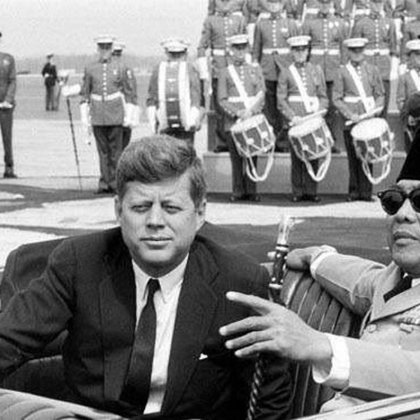PRESIDENT SUKARNO WAS INDONESIA'S THE FIRST
PRESIDENT (1901 1970), A FAMOUS CHARISMATIC LEADERSHIP.HE HAS MET
PRESIDENT JOHN F KENNEDY IN 1961. SUKARNO WAS A SYMBOL OF INDEPENDENCE
AND NATIONAL UNITY FOR INDONESIA. FROM 1950 1957 INDONESIA WAS A
LIBERAL DEMOCRACY HOWEVER AS YOUNG NATION PLAGUED WITH TURBULENCE AND
SEPARATISM.
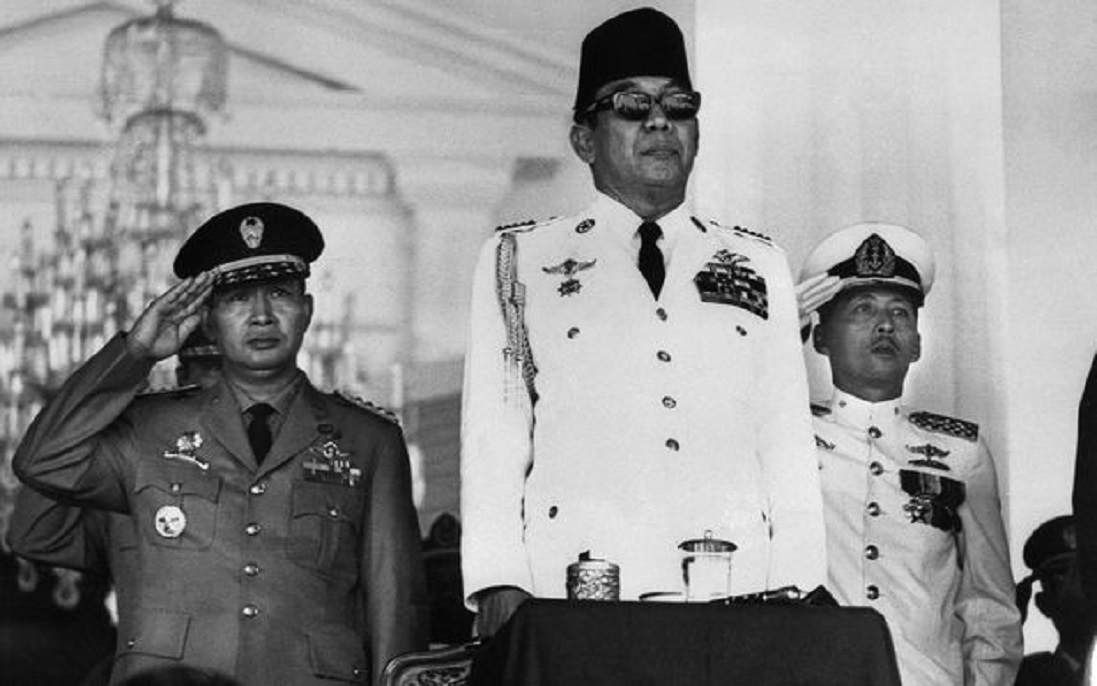 President Sukarno
has helped the country win its independence from the Netherlands and
was President from 1945 to 1967, presiding with mixed success over the
country's turbulent transition to independence. Sukarno was forced out
of power by one of his generals, Suharto, who formally became President
in March 1967.
President Sukarno
has helped the country win its independence from the Netherlands and
was President from 1945 to 1967, presiding with mixed success over the
country's turbulent transition to independence. Sukarno was forced out
of power by one of his generals, Suharto, who formally became President
in March 1967.
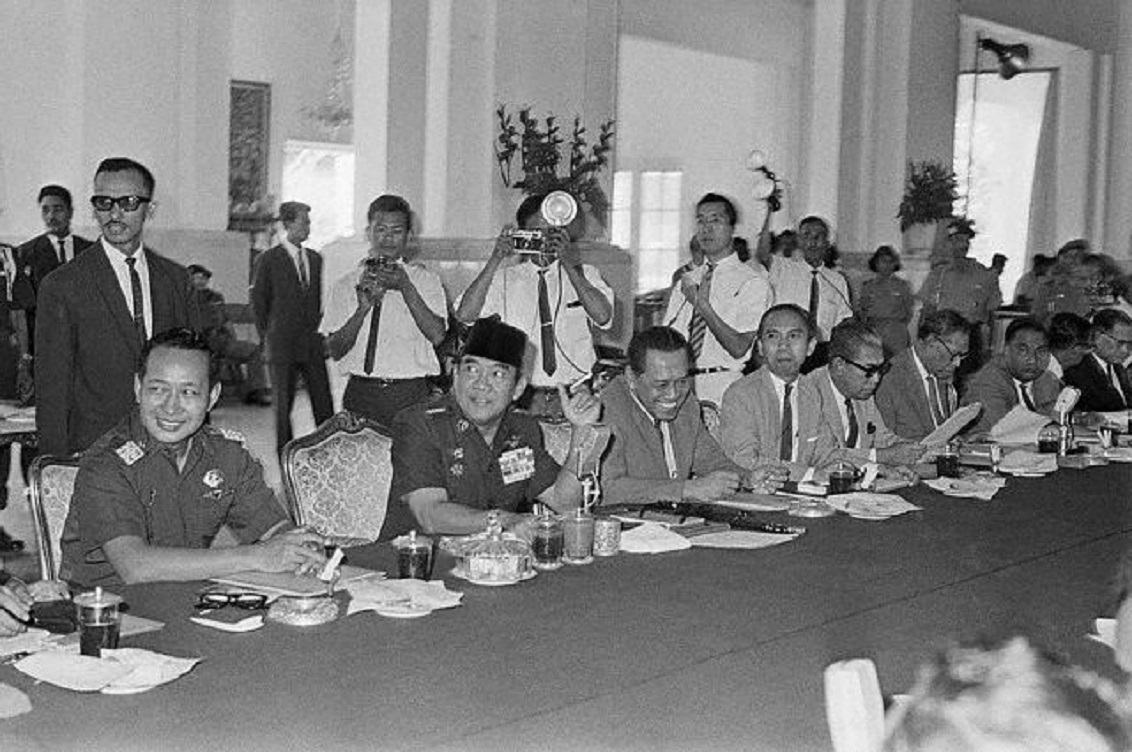 Original
caption: 8/4/1966-Jakarta, Indonesia- Members of the new Indonesian
cabinet, formed July 25th, await the start of their first meeting at
Freedom Palace. From left are: Chairman of the Presidium General
Suharto; President Sukarno; Senior Minister of Economics and Finance
S.H. Buwono IX; and Senior Minister of Politics.
Original
caption: 8/4/1966-Jakarta, Indonesia- Members of the new Indonesian
cabinet, formed July 25th, await the start of their first meeting at
Freedom Palace. From left are: Chairman of the Presidium General
Suharto; President Sukarno; Senior Minister of Economics and Finance
S.H. Buwono IX; and Senior Minister of Politics.
Sukarno , was Indonesia’s First President and one of the country’s founding fathers, and the most famous one. Sukarno
declared himself Indonesia’s president’s after the Japanese left
in 1945 and officially became the president of Indonesia when Indonesia
became independent in 1949. He preached religious and racial tolerance,
and the ideology which became the cornerstone of Indonesia's identity.
His greatest achievement was to unify Indonesia and make Javanese,
Timorese, Sumatrans and Balinese proud to call themselves Indonesians.
He founded the national ideology ( Pancasila), which he said was the
“highest common factor and the lowest common multiple of Indonesian
thought” and promoted the national language Bahasa Indonesian. He
remained president until 1967.The son of a Javanese noble and a Balinese
Brahman, he was educated in a Native Primary School and then a Dutch Primary
School (Schools were segregated based on race then) and graduated from
the Bandung Institute of Technology (ITB) in 1926 with a degree in
Engineering, hence his title “Ir.”Engineer.Sukarno (1901–70) was
the leader of the independence movement, the father of modern Indonesia
and Indonesia's first president. Known as "Bung Karno” (Brother Karno)
as well as the Great Leader of the Revolution, Mouthpiece of the
Indonesian People and Father of the Farmers, he founded the national
ideology pancasila and was the driving force behind Indonesia for the
first 17 years of its existence.Unlike most earlier nationalist leaders,
Sukarno had a talent for bringing together Javanese tradition
(especially the lore of wayang theater with its depictions of the battle
between good and evil), Islam, and his own version of Marxism to gain a
huge mass following. An important theme was what he called
"Marhaenism." Marhaen (meaning farmer in Sundanese) was the name given
by Sukarno to a man he claimed to have met in 1930 while cycling through
the countryside near Bandung. The mythical Marhaen was made to embody
the predicament of the Indonesian masses: not proletarians in the
Marxist sense, they suffered from poverty as the result of colonial
exploitation and the islands' dependence on European and American
markets.Sukarno aimed to make Javanese, Balinese, Acehese, Sumatrans and
other groups to look beyond their own ethnicity as see themselves as
Indonesians. Sukarno believed it seemed when nobody else did—that the
far flung islands of the former Dutch empire could be unified into a
nation. He was told it "is not going to work. They are totally different
people, totally different cultures...We should have nothing to do with
them." But in the end he achieved his goal with a minimum of
bloodshed.The late 1920s witnessed the rise of Sukarno to a position of
prominence among political leaders. He became the country's first truly
national figure and served as president from independence until his
forced retirement from political life in 1966. Sukarno was a charismatic
but he could also be an unpredictable demagogue who nearly bankrupted
the country. In his autobiography he wrote, "He loves his country, he
loves his people, he loves women, he loves art and, best of all, he
loves himself." Even so Sukarno was adored by Indonesians. He was good
in sports and academics and was one of the few Indonesians to be let
into a Dutch-language school. While at a Dutch-language secondary school
in Surabaya met and boarded with the country's most well known
nationalists,Cokroaminoto (Tjokroamino), who introduced the young
Sukarno to separatist politics.Sukarno was educated in East Java and
Europe before studying at the new Technical College Bandung Institute of
Technology), one of the best and most expensive schools in the colony,
where he graduated as an architect from. He associated with leaders of
the Indies Party and Sarekat Islam in his youth and was especially close
to Cokroaminoto until his divorce from Cokroaminoto's daughter in 1922.
A graduate of the technical college at Bandung in July 1927, he, along
with members of the General Study Club (Algemene Studieclub) established
the Indonesian Nationalist Union (PNI) the following year. Known after
May 1928 as the Indonesian Nationalist Party (PNI), the party stressed
mass organization, noncooperation with the colonial authorities, and the
ultimate goal of independence.It has been said that Sukarno was found
of mistresses, uniforms and bombast. He lived in a grand presidential
palace and may have had as many as nine wives. His second wife was a
Balinese Hindu. His glamorous third wife, Dewi, was a former Japanese
hostess at Tokyo's Copabacana nightclub and is now a big celebrity in
Japan. He named his son after the Indonesian words for "Lighting,"
"Thunder," and "Typhoon."Sukarno was a dashing impulsive soldier who
liked to flash a winning smile behind dark sunglasses. The Indonesian
called him bung (older brother) and felt he was one of them as well as a
charismatic leader. He practiced both Islam and Javanese mysticism.
Sukarno was also inspired by the ideals of the French Revolution and the
Enlightenment.His Ideology beyond the goal of independence, Sukarno
envisioned a future
Indonesian society freed from dependence on foreign capital: a
community of classless but happy Marhaens, (Western-style)
individualists, that would reflect the idealized values
of the traditional village, the notion of gotong-royong or mutual
self-help. Marhaenism, despite its convenient vagueness, was developed
enough that by 1933 nine theses on Marhaenism were developed in which
the concept was synonymous with socio-nationalism and the struggle for
independence. Mutual self-help in diverse contexts became a centerpiece
of Sukarno's ideology after independence and was not abandoned by his
successor, Suharto, when the latter established his New Order regime in
1966.
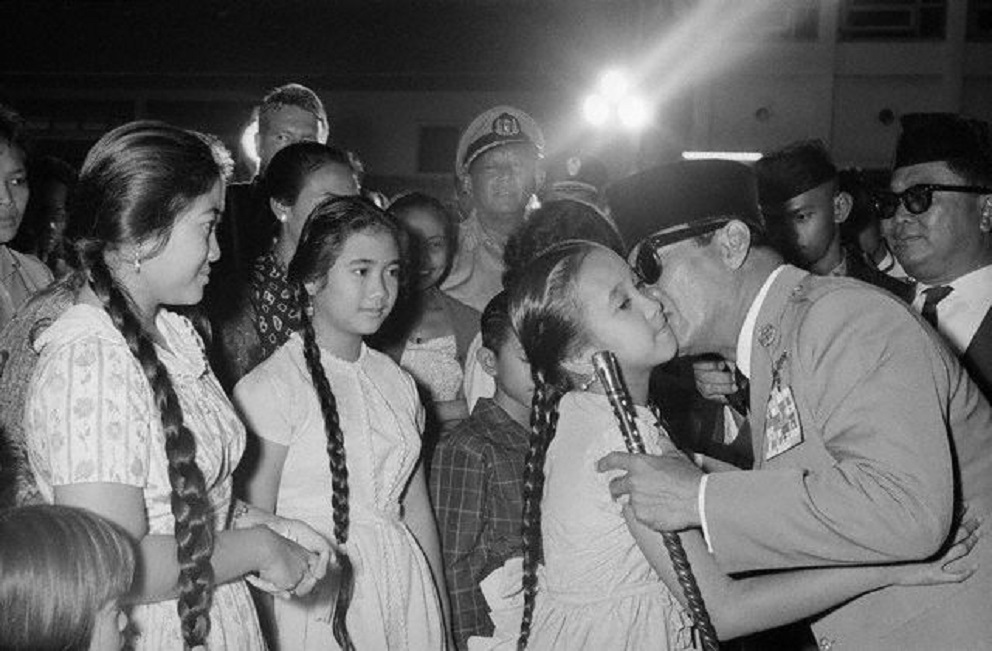 Surrounded
by citizens of Jakarta, President Sukarno kisses his youngest daughter,
Sukmawati, goodbye while his other daughters, Rachmawati (center) and
Megawati (left), wait their turn.Megawati Sukarnoputri, who served as the fifth president of Indonesia, is his daughter by his wife Fatmawati.Rachmawati
Sukarnoputri and Sukmawati Sukarnoputri have all been active in
politics. Sukarno had a daughter named Kartika by Dewi Sukarno.
Surrounded
by citizens of Jakarta, President Sukarno kisses his youngest daughter,
Sukmawati, goodbye while his other daughters, Rachmawati (center) and
Megawati (left), wait their turn.Megawati Sukarnoputri, who served as the fifth president of Indonesia, is his daughter by his wife Fatmawati.Rachmawati
Sukarnoputri and Sukmawati Sukarnoputri have all been active in
politics. Sukarno had a daughter named Kartika by Dewi Sukarno.
In 1945, a man known simply by the name Sukarno became Indonesia’s first president after leading an independence movement against Dutch colonial rule. He entered office with overwhelming popular support and was widely regarded as a national hero.He brought with him a reputation for loving his country, and for loving women. Sukarno couldn’t have anticipated it at the time, but his habits eventually attracted the interest of some of the most powerful intelligence agencies in the world.Indonesia would play an important role in the Cold War between the United States and the Soviet Union. The Pacific archipelago nation was populous, strategically vital and home to the largest communist party outside of the Soviet Union.Sukarno while not a communist himself had communist allies and shared some of the ideology’s tendencies, which did not endear him to Western leaders. For these reasons, and undoubtedly others, Moscow and Washington played tug-of-war with Indonesia for decades.On August 17, 1945 Indonesia proclaimed its independence from the Netherlands, which had maintained colonial domination over the Indonesian Archipelago for more than three and a half centuries.Up to 1949 the new republic was forced to withstand the former metropolis’s efforts to restore its colonial regime in the country. The main tasks of the newly sovereign state in the years 1945 to 1949 were to defend its independence, to strengthen its sovereignty and to achieve international recognition. Western powers, the USA and Great Britain, were inclined to directly and indirectly support the Netherlands’ efforts to reestablish its dominant influence on the Archipelago. The Indonesian leaders used the framework of the “cold war” while appealing to the Western powers to put pressure on the Netherlands to stop its military aggression against the new republic, while at the same time they were trying to get support from the newly independent countries of Asia and Africa as well as from the USSR and the socialist camp. Under Soviet initiative the “Indonesian question” was put on the agenda of the UN Security Council. During this period the Indonesian Republic was officially and unofficially recognized by many countries, including Western powers. In 1947 Indonesia signed a Friendship Agreement with Egypt, which marked a great success for the young Republic’s diplomacy. The Republic also took steps towards closer relations with the countries of the socialist camp, firstly with the USSR.On January 26, 1948, a Soviet Chargé d’Affaires in Czechoslovakia reported to his Ministry that he had received a letter from the Special Envoy and Minister Plenipotentiary of the Republic of Indonesia, Soerpino, containing a proposition to establish diplomatic relations between the USSR and Indonesia. On May 22, 1948 in the Soviet Embassy in Prague Soeripno and the Soviet Extraordinary and Plenipotentiary Ambassador to Prague exchanged notes about the establishment of consular relations and the mutual exchange of consuls. Yet under Dutch military and political pressure the Indonesian government failed to ratify this agreement.Late in 1949 Indonesia and the Netherlands met at the Round Table Conference and reached a number of agreements. The Netherlands recognized the sovereignty of Indonesia but reserved important positions in political, economic and military spheres. Indonesia was divided into 16 semi-independent states among which the Republic of Indonesia was the strongest. It proved impossible to agree about the future of West New Guinea (West Irian). The Indonesian delegation insisted that this area was part of Indonesia, but the Netherlands was determined to maintain its position there. Eventually the Indonesian side conceded that the status quo should prevail, with the stipulation that the area’s political status would be determined through negotiations between the Netherlands and Indonesia .Sovereignty was officially transferred on December 27, 1949. On January 25, 1950, after some hesitation, the Soviet Union officially recognized Indonesia upon request from the Netherlands. On February 3, 1950 the Indonesian Prime Minister sent a return telegram confirming the receipt of the Soviet telegram of recognition. This date is considered the official date of the establishment of diplomatic relations between the USSR and Indonesia.In 1950 under the influence of Indonesian nationalism all semi-independent states united with the Republic of Indonesia into the unitary state. This period of Indonesian history from 1950 till 1959 is usually described as the period of “liberal democracy.By 1956, Sukarno was openly criticising parliamentary democracy, stating that it was 'based upon inherent conflict' that ran counter to the Indonesian concept of harmony as the natural state of human relationships. Instead, he sought a system based on the traditional village system of discussion and consensus, which occurred under the guidance of village elders. He proposed a threefold blend of nasionalisme into a co-operative 'Nas-A-Kom' government. This was intended to appease the three main factions in Indonesian politics the army, Islamic groups, and the communists. With the support of the military, he proclaimed in February 1957, 'Guided Democracy', and proposed a cabinet of representing all the political parties of importance (including the PKI). Western-style parliamentary democracy was thus finished in Indonesia until the 1999 elections of the Reformasi era.One of the main themes pursued by IRD was the threat posed by the PKI and "Chinese communists". Newspaper reports continually emphasised the danger of the PKI. Drawing upon their experience in Malaya in the Fifties, the British emphasised the Chinese nature of the communist threat. Roland Challis said: "One of the more successful things which the West wished on to the non-communist politicians in Indonesia was to transfer the whole idea of communism onto the Chinese minority in Indonesia. It turned it into an ethnic thing. It is a terrible thing to have done to incite the Indonesians to rise and slaughter the Chinese."
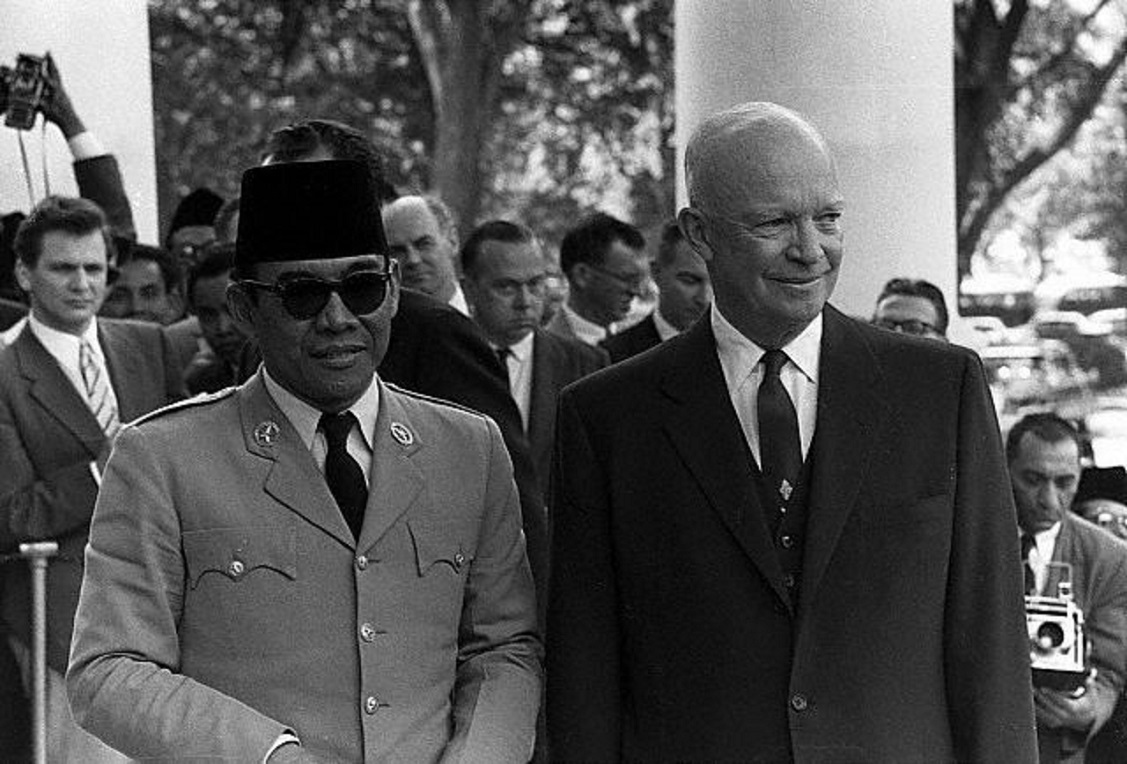 President Eisenhower with President Sukarno.Original
caption: Washington, D.C.: President Eisenhower explains the mechanics
of television to President Sukarno of Indonesia as they arrived at the
White House radio and television room where President Eisenhower was
scheduled to make a closed circuit television address.The first President of Indonesia after the country gained its independence from the Dutch in 1945. Washington, D.C
President Eisenhower with President Sukarno.Original
caption: Washington, D.C.: President Eisenhower explains the mechanics
of television to President Sukarno of Indonesia as they arrived at the
White House radio and television room where President Eisenhower was
scheduled to make a closed circuit television address.The first President of Indonesia after the country gained its independence from the Dutch in 1945. Washington, D.C
 Original
caption: 5/16/1956-Washington, DC-: Indonesia's President Achmed
Sukarno is escorted by Vice President Richard Nixon as the visiting
Chief of State received full military honors and a 21-gun salute on his
arrival at Washington National Airport at noon.
Original
caption: 5/16/1956-Washington, DC-: Indonesia's President Achmed
Sukarno is escorted by Vice President Richard Nixon as the visiting
Chief of State received full military honors and a 21-gun salute on his
arrival at Washington National Airport at noon.
Sukarno
counted John F. Kennedy among his friends. He was inspired by the
proto-fascist Italian poet Gabriele D’Annunzio who in turn was a devotee
of Nietzche. The term “live dangerously” was first used b D’Annunzio.
Sukarno used the term the “year of living dangerously” to exhort
Indonesians to prepare for hard times ahead.Indonesian
president honored at Columbia. New York, New York: Indonesian president
Sukarno is shown being invested by Dean Harry J. Carman of Columbia
with the hood of the degree of Doctor of Laws in ceremonies at the
university today. L. to R.: Dean Carman;
Dr. Sukarno and Dr. Grayson Kirk, president of Columbia. Dr. Kirk
introduced the first president of the Southeast Asia Republic as "a
political pioneer of a great frontier of today and tomorrow." Image:
Bettmann/CORBIS Date Photographed: May 24, 1956 Location Information:
New York, New York, USA .Sukarno had a mellifluous voice and a
fondness for “loopy, inventive acronyms.” He had the power to arouse
people with his oratory. His rallying cry was, “Freedom! Freedom!
Freedom!”Sukarno held crowds spellbound with his speeches and fired them
up with his rhetoric. Recalling when he was a student, a political
science professor told the Washington Post, "I had goose pimples
whenever I heard President Sukarno make speeches. But after the
speeches, we went back to the grueling life of standing in line for
soap, for rice, for basic necessities." Life was hard "but we felt like
we were traveling on top of the world. There was a great sense of
unity."While at Bandung Institute of Technology, regarded in his time as
a focal point for political activity, radical Islam and Communism. He
founded the Bandung Study Club on the model begun in Surabaya by the
early Budi Utomo leader Dr. Sutomo (1888–1938), an ophthalmologist.In
1927, Sukarno helped found the Partai National Indonesia (PNI), the
Indonesian Nationalist Party, a pro-independence organization that
blended Javanese, Western and socialist philosophies. Sukarno declared,
“Give me 10 youths who are fired with zeal and with love for our native
land, and with them I shall shake the earth.” It became the most
significant nationalist organisation and was the first secular party
devoted primarily to independence but the movement remained politically
weak until World War II.The fundamental idea that Sukarno invested in
the PNI was that achieving the nation—acquiring independence from Dutch
rule—came before and above everything else, which meant in turn that
unity was necessary. Quarrels about the role of Islam or Marxist ideas
or even democracy in an eventual Indonesia were at the moment beside the
point. Social class was beside the point. All differences dissolved
before the need for unity in reaching the goal of merdeka.The
Minangkabau Sutan Syahrir (1909-66) and Mohammad Hatta became Sukarno's
most important political rivals. Graduates of Dutch universities, they
were social democrats in outlook and more rational in their political
style than Sukarno, whom they criticized for his romanticism and
preoccupation with rousing the masses. In December 1931 they established
a group officially called Indonesian National Education (PNI-Baru) but
often taken to mean New PNI. The use of the term "education" reflected
Hatta's gradualist, cadre-driven education process to expand political
consciousness. Sukarno was arrested by the Dutch colonial government in
1929 and placed on trial for sedition in 1930, where he defended himself
with an eloquent castigation of colonialism that lasted for two days
and became known as Indonesia Menggoegat (“Indonesia Accuses!”). Sukarno
served two years in prison. When he was released in 1931 he was
regarded as hero by ordinary Indonesians. Taken into custody again in
1933, he was held under house arrest, first in remote Ende, Flores, then
in Bengkulu, western Sumatra, until the Japanese occupation. While
Sukarno was exiled on Flores, home of large number of Christians, he
wrote movingly about the common values of Catholics and Muslims. The PNI
for all intents and purposes was banned. Sukarno was freed from
confinement when the Japanese arrived in 1942 during World War
II.Sukarno collaborated with the occupying Japanese during World War II.
The Japanese allowed him to establish a nationalist umbrella group. In
Jakarta he helped recruit Indonesian laborers for the Japanese war
effort, many of who died working under slave-like conditions in Malaysia
and Burma. After the defeat of the Japanese he declared independence
from colonial rule.In 1921 Sukarno had fashioned the idea of marhaen,
the “ordinary person” representing all Indonesians, as a substitute for
the Marxist concept of proletariat, which he found too divisive, and
argued that developing a mass following among ordinary folk was the key
to defeating colonial rule. With respect to the colonial state, one was
either ko or non- ko (cooperative or not). Sukarno specified in the PNI
statutes that non-Indonesians Eurasians, Chinese, could aspire only to
associate membership at best. In his 1930 defense oration when on trial
by the colonial authorities, entitled “Indonesia Menggugat!” Sukarno
also depicted the Indonesian nation as not merely an invention of the
present but rather a reality of the historical past now being revived.
It was a glorious (racial) past leading through a dark present to a
bright and shining future.
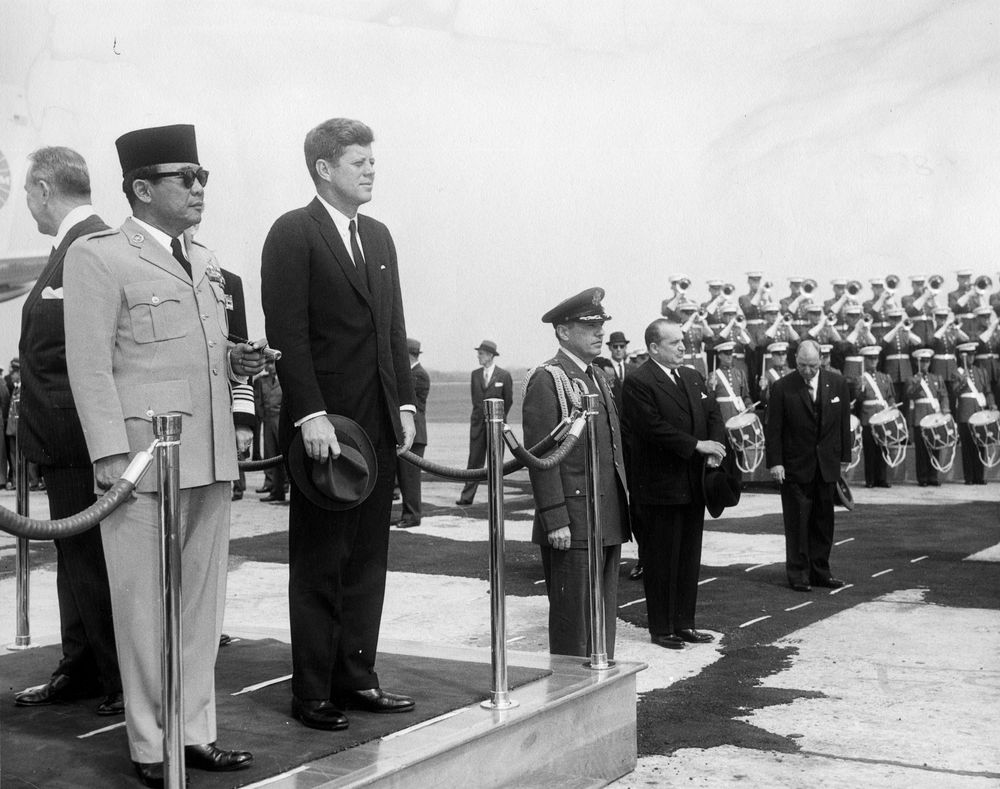 Original
caption: Sukarno inspects honor guard. andres Air Force Base, Md.:
Indonesian President Sukarno inspects the honor guard following his
arrival here today for talks with President Kennedy. Trooping the line
with him are President Kennedy and Lieutenant Colonel Charles P. Murray
Jr., commander of the troops.Presient
Sukarno Arrives For Working Lunch in Washington: Indonesian President
Sukarno is greeted by President Kennedy on the North Portico of the
White House as the former arrives today for a working lunch with the
U.S. Chief Executive, Secretary of State Dean Rusk and Indonesian
Foreign Minister Subandrio. Kennedy and Sukarno had met for an hour and a
half earlier this morning at the White House.
Original
caption: Sukarno inspects honor guard. andres Air Force Base, Md.:
Indonesian President Sukarno inspects the honor guard following his
arrival here today for talks with President Kennedy. Trooping the line
with him are President Kennedy and Lieutenant Colonel Charles P. Murray
Jr., commander of the troops.Presient
Sukarno Arrives For Working Lunch in Washington: Indonesian President
Sukarno is greeted by President Kennedy on the North Portico of the
White House as the former arrives today for a working lunch with the
U.S. Chief Executive, Secretary of State Dean Rusk and Indonesian
Foreign Minister Subandrio. Kennedy and Sukarno had met for an hour and a
half earlier this morning at the White House.
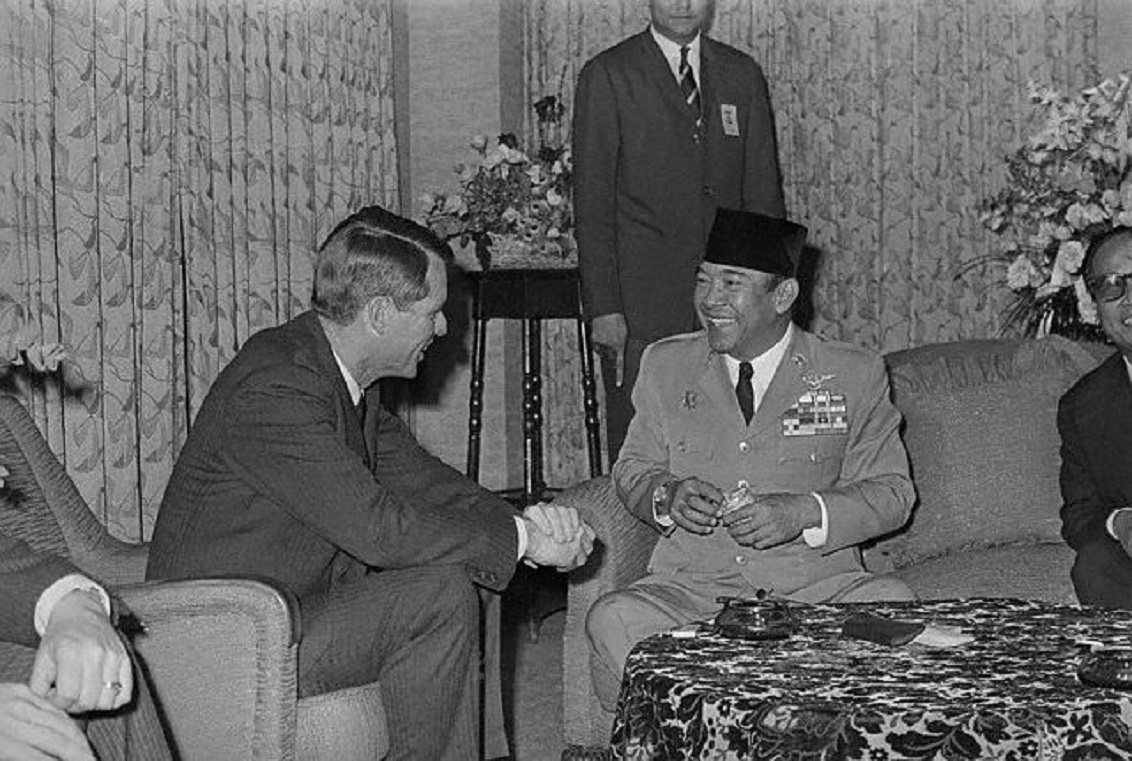 Original
caption: General Robert F. Kennedy, (L), shares a laugh with Indonesian
President Sukarno, as they discuss the Malaysia situation . The
Attorney General and Sukarno reached an agreement that the Malaysia
crisis, which threatened the peace in southeast Asia, by agreeing that
it should be solved by consultation.
Original
caption: General Robert F. Kennedy, (L), shares a laugh with Indonesian
President Sukarno, as they discuss the Malaysia situation . The
Attorney General and Sukarno reached an agreement that the Malaysia
crisis, which threatened the peace in southeast Asia, by agreeing that
it should be solved by consultation.
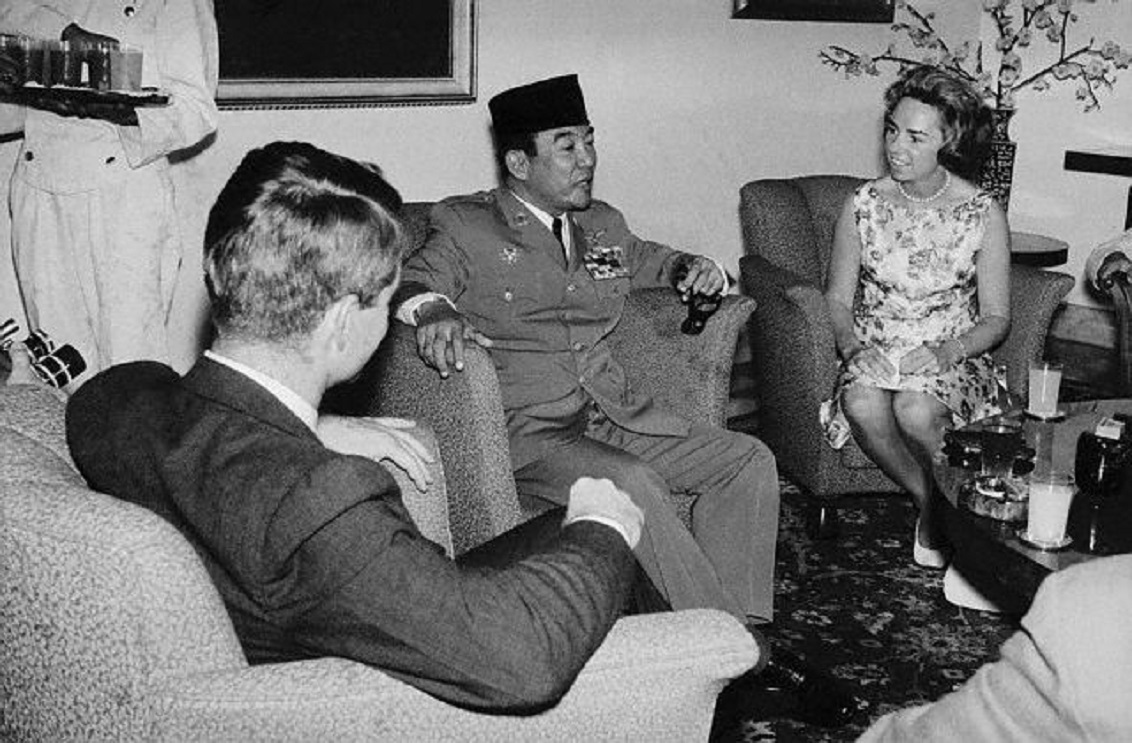 Original
caption: U. S. Attorney General Robert Kennedy, (L), and his wife visit
with Indonesian president Sukarno here. The Kennedy's lunched with
Sukarno on this "courtesy call" visit. The president's brother and
Sukarno are expected to discuss the Dutch Indonesian dispute and other
issues involving Indonesia during informal talks later during the
attorney General's six day visit to the island.
Original
caption: U. S. Attorney General Robert Kennedy, (L), and his wife visit
with Indonesian president Sukarno here. The Kennedy's lunched with
Sukarno on this "courtesy call" visit. The president's brother and
Sukarno are expected to discuss the Dutch Indonesian dispute and other
issues involving Indonesia during informal talks later during the
attorney General's six day visit to the island.
Indonesia became a valuable prize soon after independence.Soekarno was a Magnetic and Charismatic figure, which led to his reputation of being a great orator.In the early 1930s Soekarno, due to his activities, was arrested and was put into Internal Exile by the Colonial Administration on the Island of Flores. Eventually being moved to Bengkulu in Sumatra due to an outbreak of Cholera in 1938.During the Pacific War, when Indonesia came under Japanese Occupation, Soekarno chose to collaborate with the Japanese, who promised Indonesia Independence under the “Greater East Asia Co-Prosperity Sphere” supporting policies like Romusha, which conscripted millions of Indonesians as forced laborers in numerous projects, in exchange for a platform to spread his Nationalist Ideology.In 1944, as the war worsened for the Japanese Empire, it promised Soekarno Indonesia’s Independence as a final “fuck you” against the Allied Powers. With an Investigatory commission for Indonesian Independence (BPUPKI), a quasi-parliament made up of many of Indonesia’s Ethnic Groups being established with Soekarno as its head, being establised after the Liberation of the Phillipines in 1945. With Indonesia declaring its Independence on August 17th 1945, with Sukarno announcing the Declaration in Jakarta.These ideas, delivered in Sukarno’s famously charismatic style, were both radical and seductive. Part of their attraction was that they stirred deep emotions; in part, too, they permitted, even encouraged, the denial of genuine differences among Indonesians, and the highlighting of those between Indonesians and others. Not everyone agreed with the PNI program, even among those who joined. Mohammad Hatta and Sutan Syahrir, Sumatrans who were among Sukarno’s closest associates and later served him as vice president and prime minister, respectively, both had misgivings about the “mass action” approach and warned as early as 1929 against demagoguery and the growth of an intellectually shallow nationalism. Syahrir also was scathing about the sini or sana concept, especially for the way it implied an unbridgeable gap between East and West, a concept Syahrir thought both mythical and dangerous. Hatta was perhaps more equivocal, for in the Netherlands in 1926, as president of the Perhimpunan Indonesia (Indonesian Association), which had succeeded the Indonesische Vereniging, he had specifically prohibited Eurasians from membership.The encompassing, driving sense of national unity and the defiant stand against colonial rule were, nevertheless, widely appealing and influenced Indonesians everywhere. They were clearly an inspiration behind the decisions of the Second Youth Congress in 1928, which adopted the red-and-white flag and the anthem “Indonesia Raya” (Great Indonesia) as official national icons, and on October 28, 1928, passed the resolution known as the Youth Pledge (Sumpah Pemuda), which proclaimed loyalty to “one birthplace/fatherland (bertumpah darah satu, tanah air): Indonesia; one people/nation ( satu bangsa): Indonesia; and one unifying language (bahasa persatuan): Indonesian.” Little matter that, for example, the Malay language on which this new “Indonesian” was to be based was at the time little spoken among the Dutch-educated students who proclaimed it the national language; they would learn and develop it as they developed the nation itself.both needed each other. Even though he was adored by millions, Sukarno would have had a hard time surviving as long as he did without backing of the military.When elections were finally held in Indonesia in 1955, Sukarno’s party, PNI, won the most votes but did not win a majority. Faced with economic problems and separatist movements, Sukarno assumed greater authority in 1959 by establishing what he called a "guided democracy" with himself as the guide and cabinet filled with representatives of various parties that answered to him. Without offering any good reason why, he dissolved the national assembly established by the constitution of 1945 and appointed advisory councils and consolidated the 60 existing political parties into 11.In 1960, Sukarno suspended parliament and established a new one with only advisory powers. After the last rebellions against him were put down in 1962 he declared himself "president for life" in 1963. The result was deep dissatisfaction with Sukarno and the Indonesian government in general. By this time Indonesia was increasingly becoming a big mess. The government was rife with corruption and undermined by mismanagement. Rebellions broke out anew; there was great resentment against the Javanese. Sukarno’s “late reputation would rest on active self-aggrandizement.” His presidential convoy was once targeted in a a grenade attack. He survived by many were injured.In July 1958, Nasution suggested that the best way to achieve Guided Democracy was through reinstatement of the 1945 constitution with its strong "middle way," presidential system. On July 5, 1959, Sukarno issued a decree to this effect, dissolving the old House of Representatives. This marked the formal establishment of the period of Guided Democracy which lasted six years. In March 1960, a new legislature, the House of People's Representatives-Mutual Self-help (DPR-GR; later, simply DPR) was established. One hundred fifty-four of its 238 seats were given to representatives of "functional groups," including the military, which became known as Golkar. All were appointed rather than elected. As many as 25 percent of the seats were allocated for the PKI. Another body, the 616-member Provisional People's Consultative Assembly (MPRS; later, simply MPR), was established with communist leader Dipa Nusantara Aidit as deputy chairman. In August 1960, Masyumi and the PSI were declared illegal, a reflection of their role in the PRRI insurrection, the MPRS's enmity toward Sukarno, and its refusal to recognize Guided Democracy. Indonesia’s unstable political environment meant the planned 1960 election never took place. Sukarno issued a decree on July 5, 1959 to dismiss the parliament and Konstituante. He also formed new bicameral legislative agencies: Gotong Royong House of Representative (DPR GR) and a Provisional People’s Consultative Assembly (MPRS) whose members were chosen by the president himself. The dismissal of the parliament and Konstituante in 1959 marked the end of Indonesia’s parliamentary democracy and the start of the era of guided democracy which had no election until 1971, after Suharto took office.
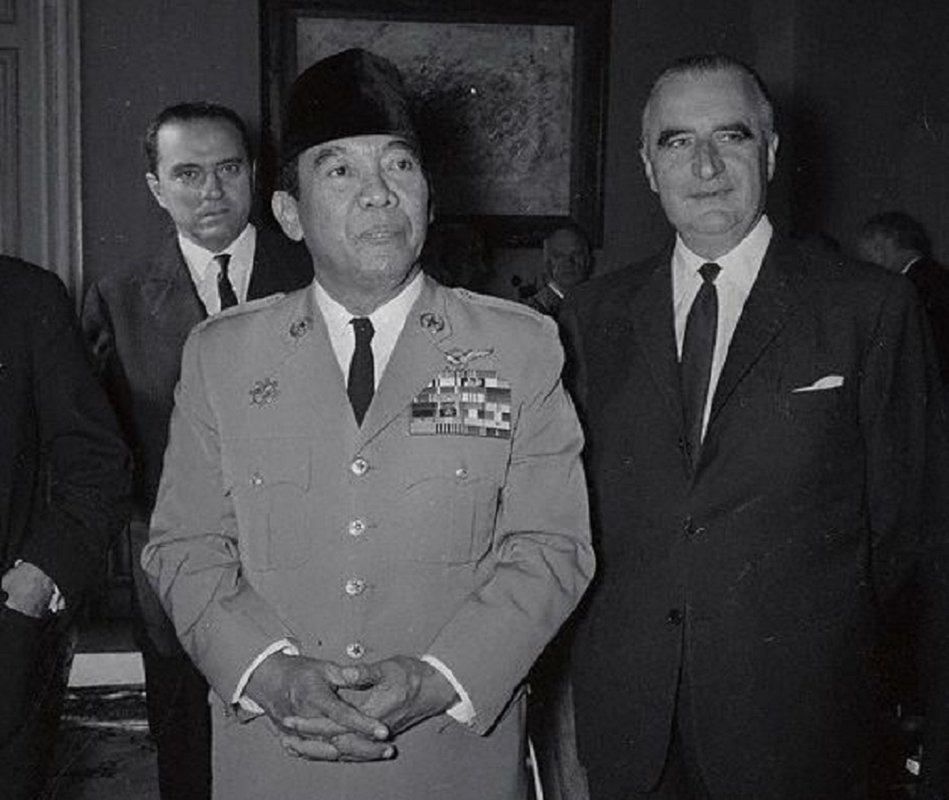 President Sukarno of Indonesia with French Premier Pompidou of France.President Sukarno of Indonesia (1901 - 1970, left) is received by French President Georges Pompidou (1911 - 1974, right) during a three-day unofficial visit to Paris, France, 20th October 1964.
President Sukarno of Indonesia with French Premier Pompidou of France.President Sukarno of Indonesia (1901 - 1970, left) is received by French President Georges Pompidou (1911 - 1974, right) during a three-day unofficial visit to Paris, France, 20th October 1964.
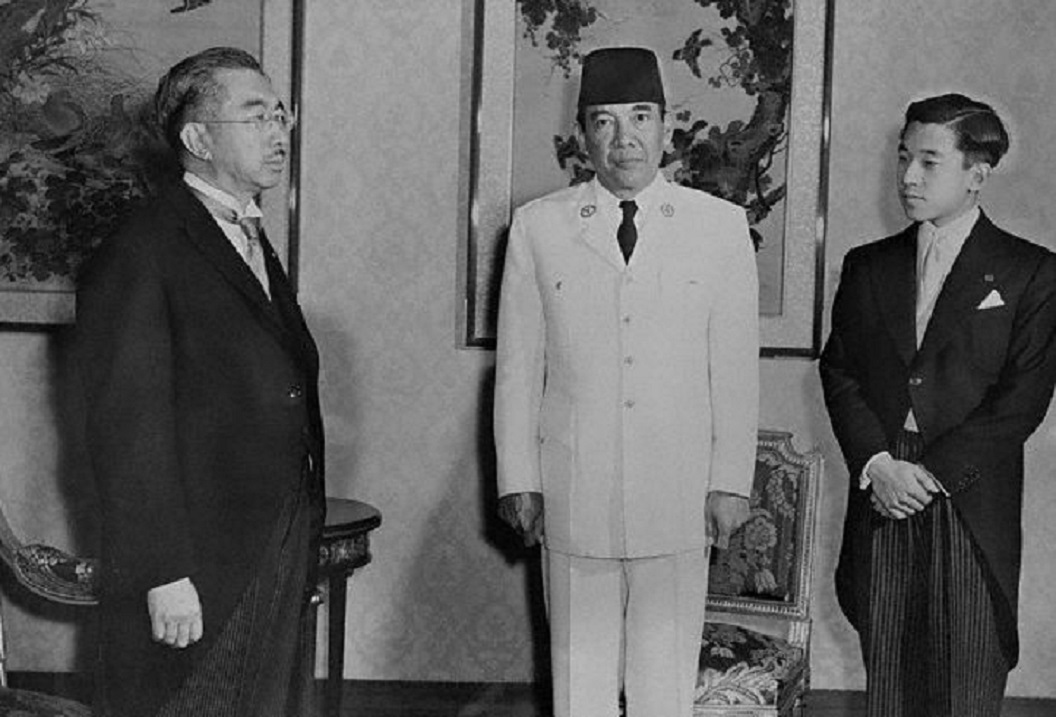 Original
caption: Sukarno Guest of Japanese Emperor. Tokyo, Japan: President
Achmed Sukarno (center) of Indonesia with Emperor Hirohito of Japan
(left) and Crown Prince Akihito when Sukarno was guest of the emperor at
luncheon in the Imperial Palace in Tokyo. The Indonesian president is
on a tour of "rest" from his presidential duties. He is being given the
red carpet treatment in Japan amid rumors that he is an unofficial link
for Afro-Asian leaders who want the US and Russia to get together in
another summit conference. February 3, 1958.
Original
caption: Sukarno Guest of Japanese Emperor. Tokyo, Japan: President
Achmed Sukarno (center) of Indonesia with Emperor Hirohito of Japan
(left) and Crown Prince Akihito when Sukarno was guest of the emperor at
luncheon in the Imperial Palace in Tokyo. The Indonesian president is
on a tour of "rest" from his presidential duties. He is being given the
red carpet treatment in Japan amid rumors that he is an unofficial link
for Afro-Asian leaders who want the US and Russia to get together in
another summit conference. February 3, 1958.
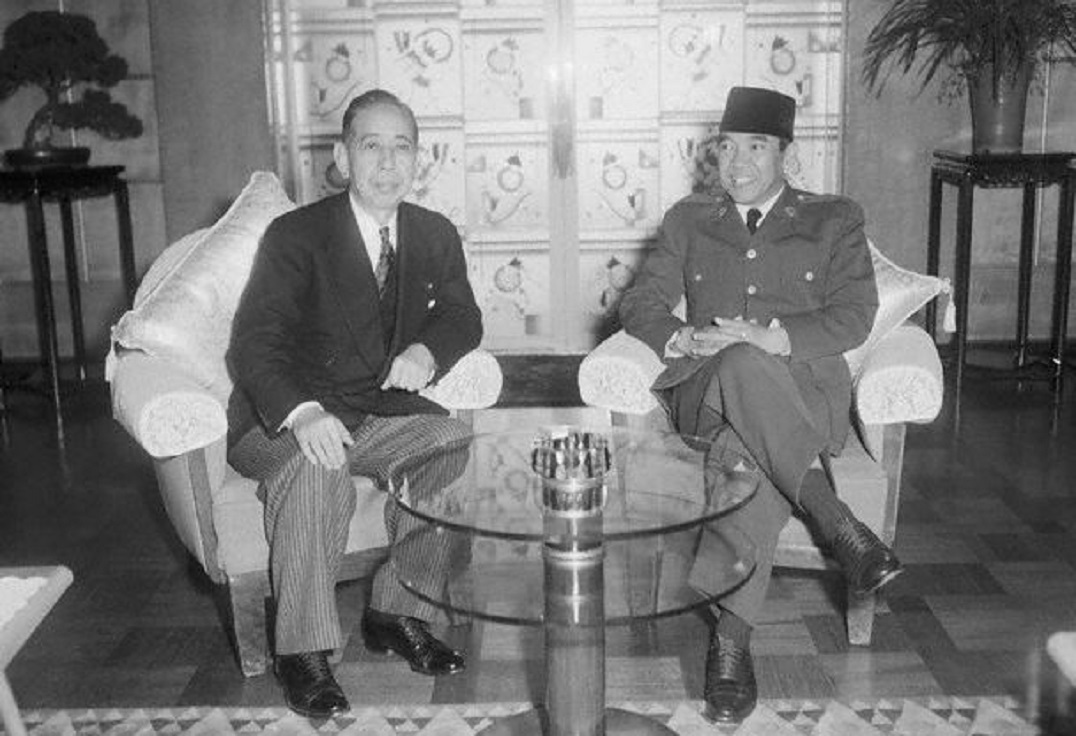 Prime
Minister Kishi Nobusuke and President Sukarno ,Japanese Prime Minister
Kishi Nobusuke (L) greets Indonesian President Sukarno during a state
visit in Tokyo, Japan.After reestablishing himself as a businessman,
Kishi resumed his political activities. He was elected to the House of
Representatives in 1953 and then helped to organize the Japan Democratic
Party.
Prime
Minister Kishi Nobusuke and President Sukarno ,Japanese Prime Minister
Kishi Nobusuke (L) greets Indonesian President Sukarno during a state
visit in Tokyo, Japan.After reestablishing himself as a businessman,
Kishi resumed his political activities. He was elected to the House of
Representatives in 1953 and then helped to organize the Japan Democratic
Party.

